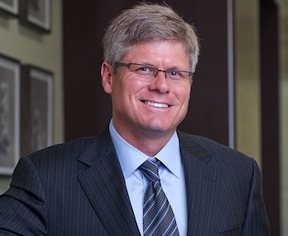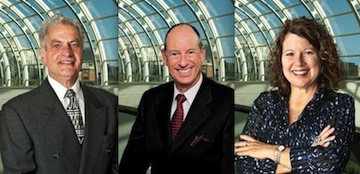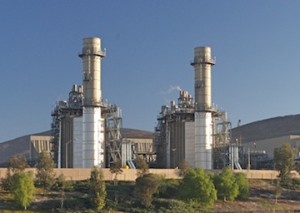Daily Business Report-Dec. 16,2013
San Diego County Home Sales Slip
San Diego County home sales in November slipped below last year’s November tally by 10.5 percent, but the median home price saw a 15.9 percent increase, according to a report by San Diego-based DataQuick.
Home Sales November 2012: 3,371
Home Sales November 2013: 3,018
Median Sales Price November 2012: $358,000
Median Sales Prive November 2013: $415,000
Southern California Totals:
Southern California’s housing market downshifted last month, with sales falling well below a year earlier as investor activity waned again and buyers continued to struggle with higher prices and a thin supply of homes for sale. The median sale price held nearly steady for the sixth consecutive month, though it was still almost 20 percent higher than a year ago, DataQuick reported.
A total of 17,283 new and resale houses and condos sold in Los Angeles, Riverside, San Diego, Ventura, San Bernardino and Orange counties last month. That was down 14.2 percent from 20,150 sales in October, and down 10.4 percent from 19,285 sales in November 2012, according to San Diego-based DataQuick.
On average, Southland sales have declined 7.6 percent between October and November since 1988, when DataQuick’s statistics begin.
Last month’s sales were 19.8 percent below the average number of sales – 21,559 – in the month of November. Southland sales haven’t been above average for any particular month in more than seven years. November sales have ranged from a low of 13,173 in November 2007 to high of 31,987 in November 1988.
The median price paid for all new and resale houses and condos sold in the six-county region last month was $385,000, up 0.3 percent from $383,750 in October and up 19.9 percent from $321,000 in November 2012. Last month’s $385,000 median price ties June, July and August as the highest for this year. The last time the median was higher than $385,000 was in February 2008, when it was $408,000 (the median was $385,000 in March and April of 2008).
“November sales were pretty underwhelming,” said John Walsh, DataQuick president. “The exact cause is tough to pinpoint, but we see likely culprits: The inventory of homes for sale still falls short of demand. Also, any pullback in home buying during the early-October fiasco in Washington D.C. would have undermined November closings, and we know investor and cash buying continued to drop. Meanwhile, home prices aren’t soaring anymore but they’re also proving to be sticky. The price jumps we saw earlier this year were driven in large part by the supply-demand mismatch. This spring could bring a substantial surge in inventory as more homeowners look to cash in on higher values. If that happens it’s going to make big price jumps less likely.”

County and Regional Water Agencies Go to Court
A judge will hear arguments this week to determine whether the Metropolitan Water District overcharges the San Diego County Water Authority by millions of dollars every year and in doing so subsidizes cheaper rates for users across the rest of Southern California. The water authority contends that Metropolitan’s alleged overbilling amounts to $57 million this year alone and cumulatively $150 million since 2011. That practice treats San Diego ratepayers as a “cash cow” for Metropolitan, the authority claims.
“The case is all about whether Metropolitan can set whatever rates it wants to charge or whether it is governed by the California Constitution and statutes that require public agencies to only recover the costs of service,” said Dennis Cushman, assistant general manager of the San Diego County Water Authority.
Metropolitan, the Los Angeles-based wholesaler that supplies the authority so it can then redistribute the water throughout the San Diego region, dismisses the allegations as false.
“Our water rates are legal and reasonable,” Marcia Scully, Metropolitan’s general counsel, responded in an interview.
This lawsuit is the latest turn in a long feud between the authority and Metropolitan, which provides water to six Southern California counties and 19 million residents.
San Diego Spins Its Wheels on Taxi Reform

San Diego taxi drivers angry the city appears to be backing away from a promise to reform what drivers say are poverty wages and unsafe working conditions, KPBS reports.
Former Mayor Bob Filner put the wheels in motion for the city to take over the taxicab industry and improve oversight. But a proposal by interim Mayor Todd Gloria to enter into a longterm contract with current taxi regulator Metropolitan Transit System could bring that work to a halt.
Under Filner, the City Council agreed to put a stay on any new contract negotiations for a year and spend $100,000 to study whether the city could regulate the taxi industry. That money was never spent and in November Gloria initiated a five-year contract with MTS.
In a letter to MTS CEO Paul Jablonski Gloria said the city’s exploration of the issue “has concluded.” The MTS executive committee then passed a draft contract. Councilwoman Marti Emerald, who sits on the committee, cast the lone nay vote. The contract moved to the MTS Board on Thursday, where Emerald, who’s also a board member, successfully tabled the final MTS vote until next year. Councilwoman Myrtle Cole seconded the motion. “The council and the mayor need to sit down and hash out a few details with regard to the proposed contract and the negotiations and confer with the city attorney just a little while longer,” Emerald said in the meeting.
In his letter to MTS, Gloria said he’d like to draft a contract that will address findings from a series of meetings between taxi drivers and cab company owners this summer. Gloria’s deputy chief of staff, Katie Keach, said he’s not opposed to a shorter contract and that industry reform “should proceed no matter who it’s under.”
Steve Mollenkopf Moves Up to Qualcomm CEO

Steve Mollenkopf was rumored as a potential candidate for the Microsoft CEO job and today he is indeed becoming the CEO-elect of a major tech company — only it’s Qualcomm, his current employer. With almost 20 years at the giant chipmaker, the last of which were spent as chief operating officer, Mollenkopf will step up to the position of Qualcomm CEO on March 4 next year. Incumbent leader Paul Jacobs will remain as executive chairman of the board of directors.
Mollenkopf joined Qualcomm’s boardon Friday and will carry on in his role as company president. March 4 marks the date of the company’s annual shareholder meeting, after which the CEO transition will be completed. Qualcomm’s board approved Mollenkopf’s selection unanimously, describing it as “a smooth transition to a proven executive.”
Qualcomm is the world’s largest wireless chip supplier and Mollenkopf has already played a large part in expanding the company’s reach. He has the technical expertise to be intimately familiar with Qualcomm’s core business, while his years as COO have seen the company establish a stranglehold on the high-end smartphone processor market.
World Trade Center San Diego Organizing
Business Mission to Australia and New Zealand
World Trade Center San Diego is organizing a business mission to Australia and New Zealand to strengthen regional business ties with visits to leading companies in Auckland, Brisbane, Melbourne and Sydney from Feb. 8-16. San Diego companies interested in expanding their international footprint are invited to join the trip. Registration deadline is Jan. 3. Cost: $1,000 for each city and $350 for a second person from the same company.
UC San Diego Health Systems Selected
For National Network on Stroke Research
UC San Diego Health Systems has been chosen to join a network of 25 nationally recognized stroke centers to address three basic features of stroke research and care — prevention, treatment and recovery. The centers were announced by the National Institutes of Health.
The regional coordinating centers, working with nearby satellite facilities, will span the country and have teams of researchers representing every stroke-related medical specialty, with the primary goal of bringing new therapies and strategies to the stroke community more rapidly.
“The new system is intended to streamline stroke research, by centralizing approval and review, lessening time and costs of clinical trials, and assembling a comprehensive data sharing system,” said Petra Kaufmann, associate director for clinical research at the National Institute of Neurological Disorders and Stroke.

Convention Center Corporation Board Gets New Leadership
Nico Ferraro, a 19-year veteran of the Plumbers and Pipefitters Union, will chair the San Diego Convention Center Corp.’s board of directors in January. Businessman Stephen Cushman was elected vice chairman of the board, and Rabbi Laurie Coskey was elected secretary-treasurer.
Ferraro worked in the pipe trades industry for 40 years. His union career ended with his retirement in 2008. Gov. Gray Davis appointed him to the Industrial Welfare Commission Wage Board.
Cushman, who has been actively involved with numerous boards and commissions, established The Cush Automotive Group and was a recognized leader in the automotive sales industry before its sale in 2006. He was recently named Mr. San Diego, 2013 by the San Diego Rotary Club for his dedication to the betterment of San Diego.
Coskey is the executive director of the Interfaith Committee for Worker Justice, an organization representing clergy, churches, mosques, synagogues, faith and justice organizations in San Diego. As a community and civil justice advocate, Coskey is chairperson of both the San Diego Community College District Trustee Advisory Board and the Clergy and Laity United for Economic Justice-California.
Otay Mesa Power Plant Proposal Under Scrutiny

The Environmental Protection Agency is in San Diego this week seeking comment on a controversial south county power project. Opponents will be on hand to protest the proposed Pio Pico natural gas plant that an energy company is hoping to build near the existing Otay Mesa power plant.
The Pio Pico power plant project is not new. In March, the California Public Utilities Commission rejected a San Diego Gas and Electric plan to buy power from the proposed natural gas facility. Regulators concluded that the region didn’t need the power.
But the Otay Mesa project was revived after San Onofre Nuclear Power Plant was shut down prematurely. The EPA is considering the plant’s air quality impacts. Opponents say the facility is wrong for the region.
“It’s unnecessary,” said Kyla Race of the Environmental Health Coalition. “It’s expensive. And it’s polluting technology that will lock the South Bay into 25 years of pollution and it locks the region into a dirty-energy future.”
The EPA meeting is simply to gather pubic comment on the plant.
Meanwhile, the California Public Utilities Commission also is mulling the future of the Pio Pico project. Its decision is expected after the first of the year. — KPBS report.
Z Microsystems Gets Northrop Grumman Contract
Z Microsystems of San Diego has received a contract from Northrop Grumman to deliver rugged military displays in support of the U.S. Army’s Ground Combat Vehicle infantry fighting vehicle. The full-term contract includes seven displays per vehicle. Under terms of the contract, Z Microsystems began shipping units to BAE Systems and Northrop Grumman in mid-2013 to support ongoing development of the Ground Combat Vehicle program. The BAE Systems-Northrop Grumman team is one of two industry groups focusing efforts on technology development contract for the U.S. Army’s GCV program.
The widescreen panel on the displays feature intuitive touch-activated controls for maximized viewing space.



